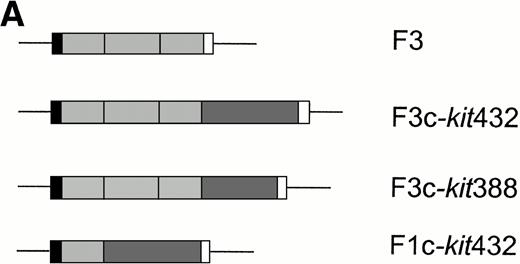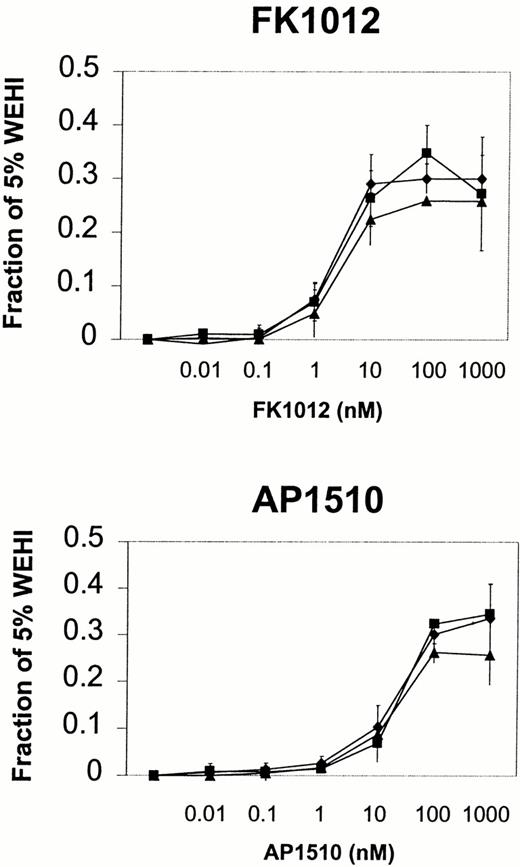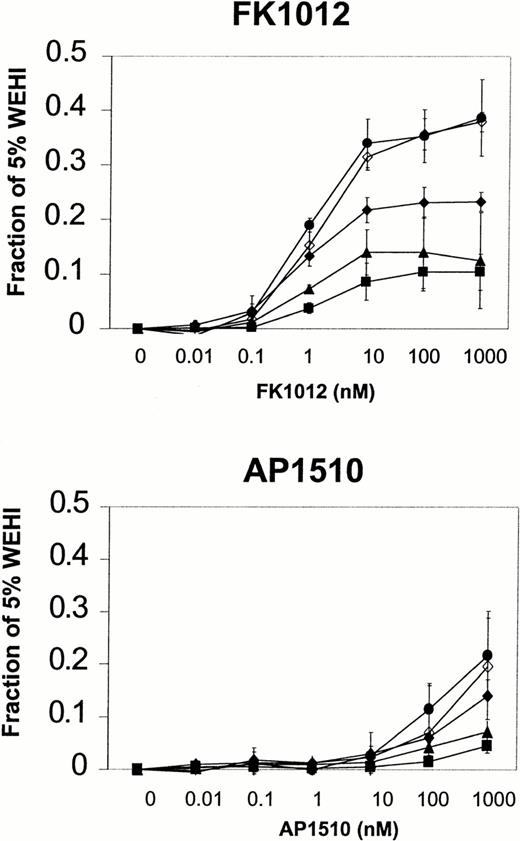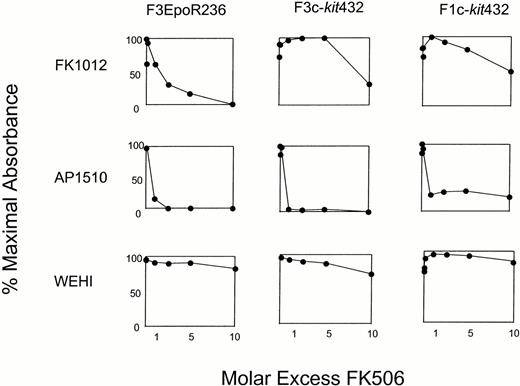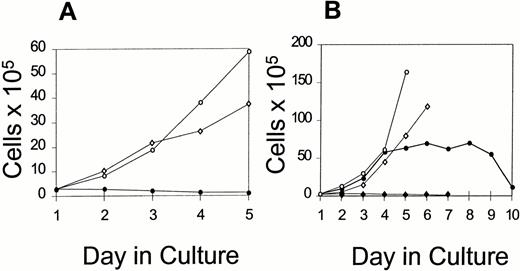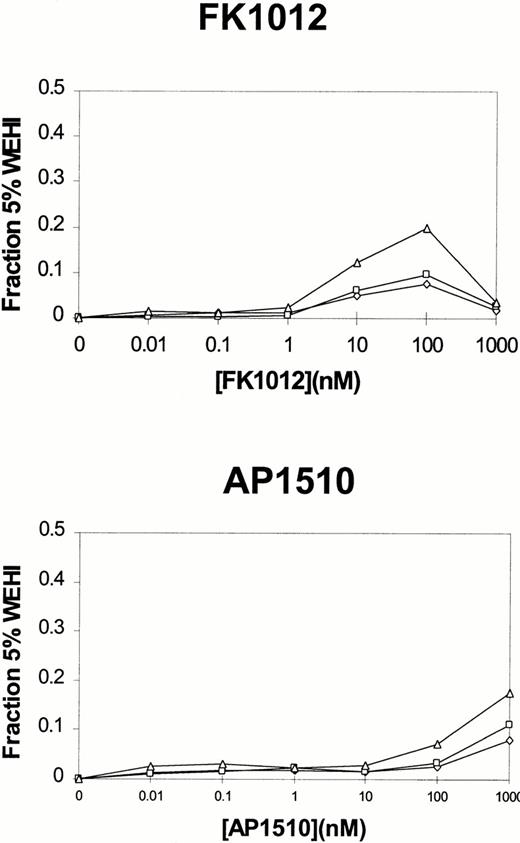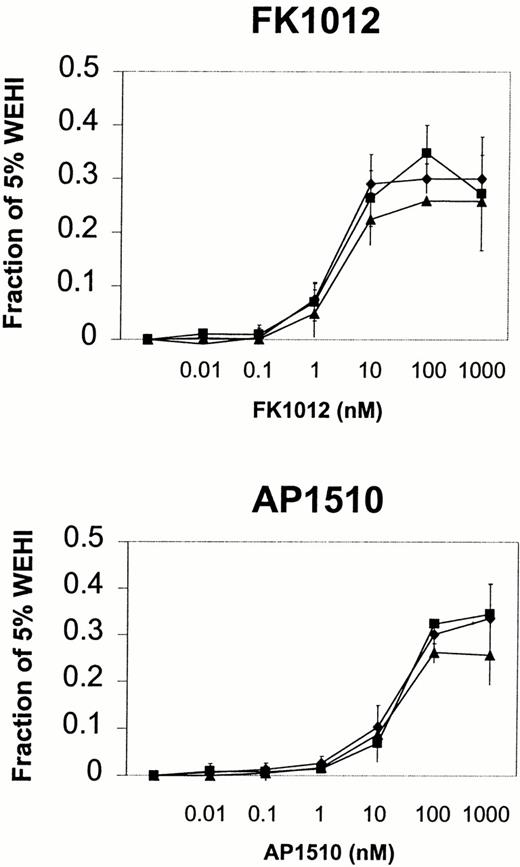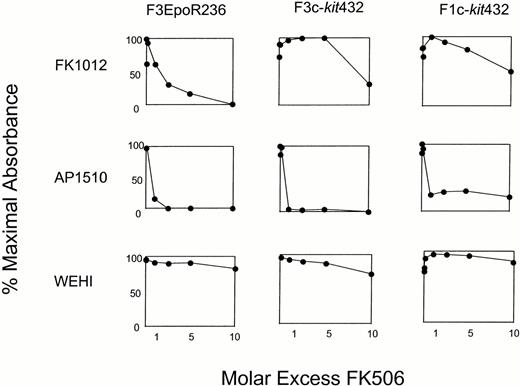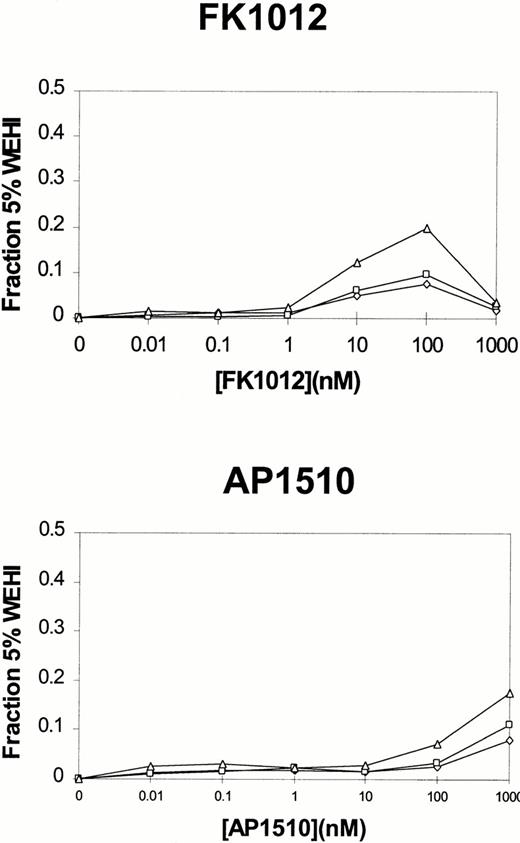Abstract
Previous studies have shown that expression of a membrane targeted chimeric protein containing the erythropoietin receptor (EpoR) cytoplasmic domain fused to the FK506-binding peptide FKBP12 allowed Ba/F3 cells to be rescued from interleukin-3 (IL-3) deprivation using a dimeric form of FK506, called FK1012. In this report, a similar approach is applied to the c-kit receptor. Expression of a membrane targeted fusion protein containing the c-kit receptor linked to one or more copies of FKBP12 allowed Ba/F3 cells to be switched from IL-3 dependence to FK1012-dependence. Similar results were obtained using an alternative dimerizer of FKBP12 domains called AP1510. Pharmacologic dimerization of chimeric proteins containing only a single FKBP12 domain confirmed that receptor dimerization is sufficient for proliferative signaling. Interestingly, while the proliferative effects of both FK1012 and AP1510 were reversible, FK1012-driven proliferation persisted for several days after drug withdrawal. Furthermore, much higher concentrations of FK506 were required to inhibit FK1012-mediated proliferation than were required to inhibit AP1510-mediated proliferation. The persistence of FK1012's effect appeared to be specific to clones expressing c-kit–containing fusion proteins. These results suggest that pharmacologically-responsive fusion proteins containing c-kitmay be useful for specifically and reversibly expanding genetically modified hematopoietic cell populations.
THE INEFFICIENCY of gene transfer into human hematopoietic stem cells poses a major obstacle for gene therapy of inherited and acquired blood cell disorders.1,2 The development of therapeutic applications for stem cell gene transfer depends on markedly increasing the proportion of genetically corrected stem cells. One strategy for increasing the frequency of modified stem cells is to induce their preferential expansion through selection.3 Providing the basis for selection are bicistronic vectors in which the nonselectable therapeutic gene is linked to a second gene encoding a selectable product. The frequency of genetically corrected cells can be increased by applying selection either ex vivo,4,5 or if a clinically tolerable regimen were devised, selection could be applied in vivo. Current methods for in vivo selection involve the transfer of a gene conferring drug resistance such as multiple drug resistance-1 (MDR1) or dihydrofolate reductase (DHFR), followed by the subsequent administration of the corresponding cytotoxic drug in vivo.6
An alternative approach for selection would be to confer a direct proliferative advantage on the genetically modified cell population. The practical application of this strategy would require that the proliferative stimulus (1) be restricted to the genetically modified population and (2) be completely reversible. We have recently reported the use of a new method that appears to meet these requirements.7 This approach is based on the principle that receptors for a variety of cytokines consist of single chains that are activated upon ligand-induced homodimerization.8 Recently developed technology allows intracellular protein dimerization to be reversibly activated in response to a lipid soluble dimeric form of the drug FK506, called FK1012.7,9-15 FK1012 is used as a pharmacologic mediator of dimerization to bring together two FK506 binding domains, taken from the endogenous protein FKBP12. Thus, fusion proteins consisting of a cytokine receptor signaling domain linked to an FKBP12 domain may be dimerized and thereby activated using FK1012.9 This approach has been used to activate apoptosis through the Fas signaling pathway15 and a related approach has been used to inducibly activate synthesis of a reporter gene in vivo.16
In recent studies,7 we have shown that FK1012-induced aggregation of a fusion protein containing the intracellular portion of the erythropoietin receptor (EpoR) allowed Ba/F3 cells, which are normally dependent on interleukin-3 (IL-3), to proliferate in its absence. This approach meets two criteria that are essential for gene therapy applications: the proliferative stimulus is restricted to the genetically modified cell population, and it is reversible. In the context of the proper signaling molecule, a similar approach may be envisioned as a means for expanding genetically modified hematopoietic stem cells. Advantages of this system for in vivo applications are that FK1012 lacks the immunosuppressive properties of FK5069 and that it can be administered at biologically effective doses.15
Toward the goal of using this approach for the expansion of genetically modified stem cells, we have tested the same strategy using a molecule, which upon activation has the reported capacity for causing stem cells to divide: c-kit.17-19 In this report, we show that Ba/F3 cells expressing a membrane-targeted chimeric protein containing the intracellular domain of c-kit linked to one or more copies of FKBP12 are capable of FK1012-dependent proliferation in the absence of IL-3. These results suggest that pharmacologic dimerization of c-kit–containing fusion proteins may be useful for expanding genetically modified hematopoietic stem cells.
MATERIALS AND METHODS
Plasmid construction.
F3, also designated pMF(PK)3E,12 is a modified form of pMF3E.9 FKBP12 has been modified to contain the mutations G89P and I90K. These mutations abrogate the ability of the FK506 complexes of this mutant FKBP to interact with calcineurin20 and have a reduced propensity to interact with cellular proteins.12 A 1296 or 1164 bp cytoplasmic domain of the murine c-kit was amplified by polymerase chain reaction (PCR) using Pfu polymerase, a plasmid containing thec-kit cDNA (a gift from Alan Bernstein, University of Toronto, Toronto, Canada) as a template and the following primers: 5′ CCC CTC GAG TAC AAA TAT TTG CAG AAA CC; 3′ (432 amino acids): CCC CTC GAG GGC ATC TTC GTG CAC; 3′ (388 amino acids): CCC CTC GAG CTT GGT GCT GTC CGA GAT. The PCR amplified fragments were digested usingXho I, gel purified, and inserted into an XhoI–digested and phophatased pBluescript vector. After sequence confirmation using the PRISM system (Applied Biosystems, Foster City, CA), the fragment was released from pBluescript byXho I digestion and ligated into the phophatased Sal I digested plasmids F3 or F1 to generate the plasmids F3c-kit432, F3c-kit388 and F1c-kit432 (Fig 1). Plasmids were purified over two sequential cesium chloride gradients before transfection.
Plasmid constructs and Western blot. (A) Schematic representation of constructs. F3, previously designated pMFPK3E12 is a modified version of pMF3E,9 where the FKBP12 domain has been modified to contain the mutations G89P and I90K. Murine c-kit receptor sequences encode either the full-length 432-amino acid cytoplasmic domain, or the membrane proximal 388 amino acid cytoplasmic domain. (▪), Myristylation peptide; (▧), FKBP12; (▪), intracellular domain of c-kit receptor; (□), HA epitope tag. (B) Western blot of protein extracts from Ba/F3 cell clones expressing the F3 and F3c-kit432 constructs display protein bands of predicted sizes.
Plasmid constructs and Western blot. (A) Schematic representation of constructs. F3, previously designated pMFPK3E12 is a modified version of pMF3E,9 where the FKBP12 domain has been modified to contain the mutations G89P and I90K. Murine c-kit receptor sequences encode either the full-length 432-amino acid cytoplasmic domain, or the membrane proximal 388 amino acid cytoplasmic domain. (▪), Myristylation peptide; (▧), FKBP12; (▪), intracellular domain of c-kit receptor; (□), HA epitope tag. (B) Western blot of protein extracts from Ba/F3 cell clones expressing the F3 and F3c-kit432 constructs display protein bands of predicted sizes.
Electroporation.
BaF3 cells were maintained in RPMI supplemented with glutamine, pyruvate, penicillin, streptomycin, 10% fetal calf serum, and 10% WEHI conditioned medium. Cells were split 1:2 on the day before transfection. Electroporations were performed as described previously.7
Western blotting.
Cells were washed twice with phosphate-buffered saline (PBS), and approximately 1 × 106 cells were lysed in 100 μL 50 mmol/L Tris pH8.0, 150 mmol/L NaCl, 1% NP40, 0.5% deoxycholate, 0.1% sodium dodecyl sulfate (SDS), and placed on ice for 30 minutes. Western assays were performed using the HA.11 antibody (Berkeley Antibody Co, Berkeley CA), as previously described.7
Cell proliferation assay.
Cell proliferation assays were evaluated by using MTT colorimetric assay (Sigma) as described previously.7 FK1012 was a gift of David Spencer (Baylor University, Houston, TX), and AP1510 was a gift of Ariad Pharmaceuticals (Boston, MA).
RESULTS
Ba/F3 cells expressing F3c-kit432 proliferate in response to FK1012.
Studies were performed to determine whether Ba/F3 cells expressing a c-kit/FKBP12 fusion protein can be induced to proliferate using FK1012. Initial studies were performed using the construct F3c-kit432 (Fig 1A). This construct was produced by inserting the cytoplasmic domain of the murinec-kit receptor into the Sal I site of the plasmid F3 (Fig 1A). F3c-kit432 encodes a chimeric protein containing a 14-amino acid myristylation-targeting domain fromc-Src21 to direct localization to the inner surface of the cell membrane, three copies of a 107-amino acid FKBP12 module22 to bind the drug FK506, the entire 432 amino acid intracellular domain of the murine c-kit receptor, and a 9-amino acid influenza HA epitope tag23 to allow detection of the recombinant protein by Western analysis.
Previous studies have shown that Ba/F3 cells expressing the full-length c-kit receptor are capable of proliferation with stem cell factor (SCF) in the absence of IL-3.24Experiments were performed to determine whether Ba/F3 cells expressing the F3c-kit432 fusion protein could, after withdrawal of IL-3, be rescued by FK1012. Ba/F3 cells were cotransfected with the F3c-kit 432 construct and a plasmid encoding neomycin phosphotransferase. G418-resistant clones were expanded and evaluated for expression of the chimeric protein by Western analysis (Fig 1B). Three Ba/F3 cell clones expressing high levels of the F3c-kit432 fusion protein were tested in cell proliferation assays. Proliferation failed to occur in the absence of IL-3–containing WEHI conditioned medium, and WEHI conditioned medium stimulated cell proliferation in a concentration-dependent manner (data not shown).
Proliferation assays were performed using the same clones in the absence of IL-3, but with the addition of either FK1012 or a new synthetic dimerizer of FKBP12 domains called AP1510. Concentrations of drug ranged from 10-2 to 103 nmol/L. As shown in Fig 2, both FK1012 and AP1510 exerted concentration-dependent proliferative effects in all three clones. To allow comparisons between the proliferative effects of FK1012, AP1510, and WEHI conditioned medium, results shown in Fig 2 indicate absorbance as a fraction of that obtained in parallel cell proliferation assays using 5% WEHI conditioned medium. For FK1012, cell proliferation was observed at as low as 1 nmol/L, peaking at concentrations of 100 nmol/L. Proliferation also occurred in response to AP1510, although approximately 10-fold higher concentrations of AP1510 were required to achieve a similar proliferative response. To show that the c-kit domain is required for mitogenic signaling, two control BaF3 clones expressing high levels of the construct F3, which lacks thec-kit domain (Fig 1), failed to proliferate in response to either FK1012 or AP1510 (data not shown).
Pharmacologic activation of c-kit stimulates cell proliferation. MTT assays for three Ba/F3 clones expressing the construct F3c-kit432. Cells were tested in the absence of IL-3 and in the presence of either FK1012 (upper panel) or an alternative dimerizer of FKBP12 domains called AP1510 (lower panel) at concentrations ranging from 10−2 nmol/L to 103 nmol/L. All Ba/F3 clones expressing F3c-kit432 showed a concentration-dependent proliferative response to both FK1012 and AP1510. Results are plotted as a fraction of OD570-630 nm values obtained using the same clone cultured in 5% WEHI conditioned medium. Data points indicate mean values of three separate experiments. Error bars indicate standard deviations. Note that in comparison to FK1012, approximately 10-fold higher concentrations of AP1510 are required to achieve equivalent proliferative effects.
Pharmacologic activation of c-kit stimulates cell proliferation. MTT assays for three Ba/F3 clones expressing the construct F3c-kit432. Cells were tested in the absence of IL-3 and in the presence of either FK1012 (upper panel) or an alternative dimerizer of FKBP12 domains called AP1510 (lower panel) at concentrations ranging from 10−2 nmol/L to 103 nmol/L. All Ba/F3 clones expressing F3c-kit432 showed a concentration-dependent proliferative response to both FK1012 and AP1510. Results are plotted as a fraction of OD570-630 nm values obtained using the same clone cultured in 5% WEHI conditioned medium. Data points indicate mean values of three separate experiments. Error bars indicate standard deviations. Note that in comparison to FK1012, approximately 10-fold higher concentrations of AP1510 are required to achieve equivalent proliferative effects.
Dimerization of the FKBP12/c-kit fusion protein is sufficient for proliferative signaling.
The presence of three FKBP12 domains in F3c-kit432 could allow FK1012 or AP1510 to stimulate proliferation either through dimerization or through oligomerization of the chimeric molecule. To distinguish between these two possibilities for c-kit activation, a construct was produced in which the 432-amino acid c-kitreceptor was linked to only a single copy of the FKBP12 domain (F1c-kit432) (Fig 1 A). Proliferation in response to FK1012 or AP1510 in cells expressing this fusion protein can be caused only by dimerization. As shown in Fig 3, five Ba/F3 cell clones expressing F1c-kit432 exhibited proliferative responses to both FK1012 and AP1510. In parallel assays, the level of cell proliferation observed in these clones appeared to be slightly reduced compared with clones expressing F3c-kit432. These results confirm that dimerization of c-kit is sufficient for mitogenic signaling.
Dimerization of c-kit is sufficient for proliferative signaling. MTT assays were performed on five Ba/F3 clones expressing the construct F1c-kit432 in the absence of IL-3 and in the presence of increasing concentrations of either FK1012 (upper panel) or AP1510 (lower panel). Results are plotted as a fraction of the OD570-630 measured from the same cells cultured in 5% WEHI conditioned medium. Data points indicate mean values of three separate experiments. Error bars indicate standard deviations. Note that the level of cell proliferation observed is slightly reduced compared with Ba/F3 cell clones expressing the F3c-kit432 construct.
Dimerization of c-kit is sufficient for proliferative signaling. MTT assays were performed on five Ba/F3 clones expressing the construct F1c-kit432 in the absence of IL-3 and in the presence of increasing concentrations of either FK1012 (upper panel) or AP1510 (lower panel). Results are plotted as a fraction of the OD570-630 measured from the same cells cultured in 5% WEHI conditioned medium. Data points indicate mean values of three separate experiments. Error bars indicate standard deviations. Note that the level of cell proliferation observed is slightly reduced compared with Ba/F3 cell clones expressing the F3c-kit432 construct.
FK506 efficiently competes FK506-mediated cell proliferation, but inefficiently competes FK1012-mediated cell proliferation.
To test the hypothesis that FK1012 and AP1510 activate cell proliferation by bringing together FKBP12 domains of adjacent FKBP12/c-kit fusion proteins, competition assays were performed using the monomer FK506. Cells were grown in the presence of either FK1012 (100 nmol/L), AP1510 (100 nmol/L), or WEHI conditioned medium (1%), and a range of FK506 concentrations. Ba/F3 clones expressing either F3c-kit432 or F1c-kit432 were tested, and compared with a Ba/F3 clone expressing the construct F3EpoR236,7 which contains the intracellular domain of the murine erythropoietin receptor inserted into the correspondingSal I site of F3 (Fig 1A). In Ba/F3 cells expressing F3EpoR236, FK506 exerted a concentration-dependent inhibition of FK1012-mediated cell proliferation (Fig 4), identical to results reported previously.7 Similar results were obtained in the presence of AP1510, although lower doses of FK506 were required for complete inhibition, consistent with AP1510's approximately 20-fold lower binding affinity for FKBP12 relative to FK506.24a As expected, FK506 exerted no effect on IL-3–mediated proliferative signaling.
FK506 efficiently competes AP1510-mediated cell proliferation, but inefficiently competes FK1012-mediated cell proliferation. MTT assays were performed using clonal populations of Ba/F3 cells expressing F3EpoR236 (left column), F3c-kit432 (middle column), or F1c-kit432 (right column). Cells were grown in the presence of 100 nmol/L FK1012 (upper panels), 100 nmol/L AP1510 (middle panels), or 1% IL-3–containing WEHI conditioned medium (lower panels), plus FK506 at the indicated concentrations. Note that in the presence of WEHI conditioned medium, FK506 failed in all cases to inhibit cell proliferation (lower panels). In contrast, for each clone FK506 exerted a concentration-dependent inhibition of AP1510-mediated cell proliferation (middle panels). Similarly, in a Ba/F3 cell clone expressing F3EpoR236, FK506 produced a concentration-dependent inhibition of FK1012-dependent cell proliferation. In contrast, both Ba/F3 cell clones expressing fusion proteins containing c-kit(F3c-kit432 and F1c-kit432) were resistant to FK506-mediated inhibition of FK1012-dependent cell proliferation. Repeat experiments using the same clones and different clones expressing the same constructs yielded very similar results.
FK506 efficiently competes AP1510-mediated cell proliferation, but inefficiently competes FK1012-mediated cell proliferation. MTT assays were performed using clonal populations of Ba/F3 cells expressing F3EpoR236 (left column), F3c-kit432 (middle column), or F1c-kit432 (right column). Cells were grown in the presence of 100 nmol/L FK1012 (upper panels), 100 nmol/L AP1510 (middle panels), or 1% IL-3–containing WEHI conditioned medium (lower panels), plus FK506 at the indicated concentrations. Note that in the presence of WEHI conditioned medium, FK506 failed in all cases to inhibit cell proliferation (lower panels). In contrast, for each clone FK506 exerted a concentration-dependent inhibition of AP1510-mediated cell proliferation (middle panels). Similarly, in a Ba/F3 cell clone expressing F3EpoR236, FK506 produced a concentration-dependent inhibition of FK1012-dependent cell proliferation. In contrast, both Ba/F3 cell clones expressing fusion proteins containing c-kit(F3c-kit432 and F1c-kit432) were resistant to FK506-mediated inhibition of FK1012-dependent cell proliferation. Repeat experiments using the same clones and different clones expressing the same constructs yielded very similar results.
Surprisingly, evaluation of Ba/F3 cells expressing FKBP12/c-kitfusion proteins showed significantly different findings (Fig 4). In Ba/F3 cells expressing F3c-kit432, equimolar concentrations of FK506 failed to reduce FK1012-dependent cell proliferation, and a significant degree of proliferation persisted despite the presence of a 10-fold molar excess of competing monomer. At a 100-fold excess of FK506, complete inhibition of FK1012-dependent proliferation was finally observed. The same results were obtained irrespective of whether FK506 or FK1012 was added to the cells first. In contrast for AP1510, equimolar concentrations of FK506 resulted in a nearly complete inhibition of AP1510-mediated cell proliferation. These results suggest that while FK506 efficiently competes with AP1510 for access to FKBP12 sites, the monomer appears to be surprisingly less efficient in competing with its dimeric counterpart, FK1012. Similar results were obtained using F1c-kit432: FK506 efficiently inhibited AP1510-dependent cell proliferation, but inhibition of FK1012-mediated proliferation was highly inefficient (Fig 4). As expected, the doses of FK506 used had no significant effect on IL-3–mediated cell proliferation.
Persistence of FK1012-mediated cell proliferation after drug withdrawal.
To confirm that the proliferative effects of FK1012 and AP1510 are reversible, cells initially cultured in the presence of either FK1012 or AP1510 were observed for cessation of cell growth after drug withdrawal. Ba/F3 cells expressing the F3c-kit432 fusion protein were plated in media without IL-3 supplemented with either FK1012 or AP1510 (both 100 nmol/L). As shown in Fig 5, cell proliferation was observed in response to either compound, while in the absence of either drug or IL-3, cells died over a period of 2 to 3 days. Similar to results obtained in the MTT assays, FK1012 appeared to be a slightly more potent stimulator of cell proliferation than was AP1510 at the concentrations examined. After 3 days of culture, cells grown initially in FK1012 or in AP1510 were washed extensively and then cultured either in the presence or absence of added drug. Cells grown initially in AP1510 died within 24 to 48 hours after drug withdrawal. In contrast, cells grown initially in FK1012 continued to slowly proliferate for up to 7 days after FK1012 was withdrawn. Thereafter, continued deprivation of FK1012 eventually resulted in cell death (Fig 5). Similar results were obtained with Ba/F3 cell clones expressing the F1c-kit432 fusion protein (data not shown). Taken together with results from the competition assays, these findings suggest that FK1012 binding to the FKBP12/c-kit fusion protein may persist for several days after drug withdrawal.
Persistence of FK1012-mediated cell proliferation after drug withdrawal. (A) A clonal population of Ba/F3 cells expressing F3c-kit432 proliferates in IL-3–deficient medium supplemented with either FK1012 (○) or AP1510 (◊) (both 100 nmol/L). In the absence of either drug or IL-3 (•), cells died over a period of 2 to 3 days. (B) The same cells grown initially in FK1012 or in AP1510 were washed extensively and then cultured either in the presence or absence of added drug. In the continued presence of FK1012 (○) or AP1510 (◊), continued cell proliferation was observed. After withdrawal of AP1510 (⧫), cell death occurred over 1 to 2 days. In contrast, cells grown initially in FK1012 continued to proliferate for up to 1 week after FK1012 was withdrawn (•). Very similar findings were observed in a repeat experiment.
Persistence of FK1012-mediated cell proliferation after drug withdrawal. (A) A clonal population of Ba/F3 cells expressing F3c-kit432 proliferates in IL-3–deficient medium supplemented with either FK1012 (○) or AP1510 (◊) (both 100 nmol/L). In the absence of either drug or IL-3 (•), cells died over a period of 2 to 3 days. (B) The same cells grown initially in FK1012 or in AP1510 were washed extensively and then cultured either in the presence or absence of added drug. In the continued presence of FK1012 (○) or AP1510 (◊), continued cell proliferation was observed. After withdrawal of AP1510 (⧫), cell death occurred over 1 to 2 days. In contrast, cells grown initially in FK1012 continued to proliferate for up to 1 week after FK1012 was withdrawn (•). Very similar findings were observed in a repeat experiment.
Deletion of the carboxy terminal end of the c-kit receptor reduces responsiveness to FK1012 and AP1510.
Deletion of the carboxy-terminus of a related receptor c-fms, results in an increased receptor sensitivity to ligand-dependent activation.25 26 To determine whether negative growth regulatory domains reside in the carboxy terminal tail of c-kit, the construct F3c-kit388 was produced, in which the carboxy terminal 44 amino acids of c-kit were deleted (Fig1A). Five BaF3 clones expressing the F3c-kit388 were generated. As shown in Fig 6, both FK1012 and AP1510 exerted concentration-dependent proliferative effects in the absence of IL-3. However, in parallel comparisons with BaF3 clones expressing F3c-kit432, truncation of the c-kit receptor appeared to significantly decrease responsiveness to FK1012 and AP1510. These findings are not attributable to differences in the level of receptor expression (data not shown).
Deletion of the carboxy-terminal 44 amino acids of c-kit reduces proliferation in response to FK1012 and AP1510. MTT assays were performed on three Ba/F3 clones expressing F3c-kit388, in which the carboxy terminal 44 amino acids of the c-kit receptor were deleted. Each clone responded to both FK1012 (upper panel) and AP1510 (lower panel), however, the level of proliferation was less than in clones expressing F3c-kit432 (Fig 2). Results are plotted as a fraction of the OD570-630 value measured from the same cells cultured in 5% WEHI conditioned medium. A second experiment yielded very similar results.
Deletion of the carboxy-terminal 44 amino acids of c-kit reduces proliferation in response to FK1012 and AP1510. MTT assays were performed on three Ba/F3 clones expressing F3c-kit388, in which the carboxy terminal 44 amino acids of the c-kit receptor were deleted. Each clone responded to both FK1012 (upper panel) and AP1510 (lower panel), however, the level of proliferation was less than in clones expressing F3c-kit432 (Fig 2). Results are plotted as a fraction of the OD570-630 value measured from the same cells cultured in 5% WEHI conditioned medium. A second experiment yielded very similar results.
DISCUSSION
Fundamental to the success of stem cell gene therapy is the development of methods for increasing the frequency of genetically corrected stem cells. This task may in theory be accomplished through selection. Selection can be applied either ex vivo, or if a clinically tolerable approach were devised, repeated cycles of selection could potentially be applied in vivo. Current approaches for in vivo selection involve the transfer of a drug resistance gene into a small population of hematopoietic cells. Selective pressure is applied through in vivo administration of the appropriate cytotoxic drug. Success requires that the cytotoxic drug exert a proportionally greater toxic effect on the population of unmodified marrow cells relative to their transduced counterparts. Recent studies have underscored a major problem in using drug resistance genes for in vivo selection: early hematopoietic cells tolerate very high dosages of the chemotherapy drugs to which these genes confer resistance.27,28 Thus, chemotherapy provides little or no selective advantage to clonogenic progenitors bearing the drug resistance gene, as these early hematopoietic cells are normally highly drug-resistant.27-30
An alternative method for accomplishing selection would be to confer a direct proliferative advantage on the genetically modified cell population. The clinical applicability of this approach would mandate that the proliferative advantage be reversible. The use of pharmacologic inducers of dimerization7-13 may provide a method for achieving this goal. Using fusion proteins containing the erythropoietin receptor, we have recently reported the development of a “proliferation switch.”7 In Ba/F3 cells expressing the FKBP12/EpoR chimeric protein, the addition of FK1012 switches cell proliferation to the “on” position, and withdrawal of FK1012 switches proliferation to the “off” position. Toward the goal of testing whether a similar approach might be used for the expansion of genetically modified hematopoietic stem cells, we tested this strategy using c-kit.
Mutations at the white spotting (W) and steel (Sl) loci provide the most compelling evidence for a biologic role of c-kit and its ligand, respectively, in stem cell regulation.31,32 Normal marrow cells introduced intoW/Wv mice can repopulate the entire hematopoietic system without conditioning, indicating a severe defect in the repopulating ability of stem cells in these animals.33Further evidence comes from the severe pancytopenia that results from administration of an antibody directed against c-kit in mice.34 C-kit ligand (SCF) administration in vivo stimulates the redistribution and expansion of progenitors.35-37 Furthermore, SCF administration produces a threefold expansion in the total number of transplantable stem cells in mice when given alone17 and a 10-fold expansion when given in combination with granulocyte colony-stimulating factor (G-CSF) in splenectomized mice.19
In this report, we show that Ba/F3 cells expressing FKBP12/c-kit fusion proteins can proliferate in response to either FK1012 or a new synthetic FKBP12 dimerizer, called AP1510. After IL-3 withdrawal, Ba/F3 cells expressing the F3c-kit432 fusion protein could be rescued and maintained in either FK1012 or AP1510. Approximately 10-fold higher concentrations of AP1510 were required to achieve a level of proliferation similar to that observed with FK1012, possibly due to AP1510's 20-fold lower binding affinity for FKBP12 domains.24a
Several findings in this report differ from our previous observations using the erythropoietin receptor. First, in the context of the erythropoietin receptor, a fusion protein containing three FKBP12 domains was significantly more efficient in stimulating FK1012-mediated cell proliferation than was a fusion protein containing only a single FKBP12 domain.7 In the case of c-kit, the difference in the level of proliferation observed in clones expressing fusion proteins with a single FKBP12 domain appeared to be only slightly reduced compared with clones with fusion proteins containing three FKBP12 domains. These results suggest that dimers may be nearly as efficient as oligomers in the stimulation of c-kit-mediated proliferative signaling. Retaining only a single FKBP12 domain has potential advantages for the development of retroviral vectors with regard both to the reduction in insert size and to the avoidance of repeated sequences that may promote recombination.
Unexpectedly, fusion proteins containing c-kit require extremely high concentrations of FK506 to inhibit FK1012's proliferative effect. Equimolar concentrations of FK506 had no discernible effect on FK1012-dependent cell proliferation, and even a 10-fold molar excess of competing monomer failed to completely inhibit FK1012's effect. In contrast, FK506 efficiently inhibited AP1510-driven cell proliferation. Furthermore, FK506 efficiently competed with FK1012 in parallel experiments using a clone expressing F3EpoR236. These observations suggest that c-kit may in some way stabilize the interaction between the FKBP12 moiety of the fusion protein and FK1012. The hypothesis that FKBP12/c-kit fusion proteins bind FK1012 in a highly stable manner is supported by our observation that cell proliferation persists for up to 1 week after FK1012 withdrawal (Fig 5). In this regard, it is noteworthy that after prolonged maintenance in IL-3–containing cultures (12 to 16 weeks), some Ba/F3 cell clones expressing FKBP12/c-kit acquire the capacity for factor independent cell growth, but remain FK1012 responsive (data not shown). The significance of these findings awaits testing in transduced primary murine bone marrow cells.
In view of the short in vivo half lives of both FK1012 and AP1510 (Spencer et al15 and Amara et al24a), drug concentrations attainable in vivo are likely to be low. Thus, signaling molecules that can be activated at very low drug concentrations may be advantageous. Several mutations in the cytoplasmic domain of c-kit have the capacity to trigger constitutive receptor activation and neoplastic transformation.38,39 Sequence differences between the feline v-kit oncogene and feline c-kit include the replacement of the carboxy-terminal 44 amino acids in c-kit by five unrelated amino acids in v-kit. Other reports indicate that negative regulatory domains may reside within the carboxy terminal end of another class III receptor tyrosine kinase, c-fms.25,26 In our studies, deletion of 44 amino acids from the carboxy terminal end of c-kit failed to augment responsiveness to either FK1012 or AP1510 and appear, in fact, to have resulted in an impairment of receptor function. The lack of an increase in receptor sensitivity is in agreement with a previous report and suggest that remaining sequence differences between v-kitand c-kit require evaluation.40
An eventual goal of our studies is to identify signaling domains that stimulate stem cells to divide, but not to differentiate. Pharmacologic activation of wild-type c-kit, which is also a major regulator of mast cell differentiation,41-44 is unlikely to fulfill this goal. Urgently needed are approaches for the identification and, if possible, the elimination of domains necessary for maturational signaling.
Although our studies show that FK1012 or AP1510 can rescue a factor-dependent cell line, demonstrating a proliferative advantage in genetically modified primary cells may be more difficult, particularly for in vivo applications. In Ba/F3 cells, withdrawal of IL-3 provides a strong selective pressure that is not reproducible in vivo. Whether pharmacologic inducers of dimerization can provide a proliferative stimulus in transduced primary cells beyond that provided by a physiologic milieu of cytokines remains to be determined.
ACKNOWLEDGMENT
The authors thank Alan Bernstein for his gift of the murine c-kit cDNA, David Spencer for FK1012, and Mike Gilman and Jane Amara for AP1510 and for access to their results prior to publication.
Supported by Grants No. 1R01 DK52997-01, 5P01 HL53750, and 5P30 DK47754 from the National Institutes of Health, Bethesda, MD.
Address reprint requests to C. Anthony Blau, MD, Mail Stop 357710, Health Sciences Building, Division of Hematology, Department of Medicine, University of Washington, Seattle, WA 98195.
The publication costs of this article were defrayed in part by page charge payment. This article must therefore be hereby marked “advertisement” in accordance with 18 U.S.C. section 1734 solely to indicate this fact.

